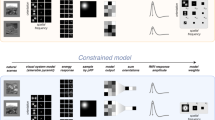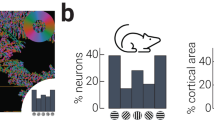Abstract
The potential for human neuroimaging to read out the detailed contents of a person's mental state has yet to be fully explored. We investigated whether the perception of edge orientation, a fundamental visual feature, can be decoded from human brain activity measured with functional magnetic resonance imaging (fMRI). Using statistical algorithms to classify brain states, we found that ensemble fMRI signals in early visual areas could reliably predict on individual trials which of eight stimulus orientations the subject was seeing. Moreover, when subjects had to attend to one of two overlapping orthogonal gratings, feature-based attention strongly biased ensemble activity toward the attended orientation. These results demonstrate that fMRI activity patterns in early visual areas, including primary visual cortex (V1), contain detailed orientation information that can reliably predict subjective perception. Our approach provides a framework for the readout of fine-tuned representations in the human brain and their subjective contents.
This is a preview of subscription content, access via your institution
Access options
Subscribe to this journal
Receive 12 print issues and online access
$209.00 per year
only $17.42 per issue
Buy this article
- Purchase on Springer Link
- Instant access to full article PDF
Prices may be subject to local taxes which are calculated during checkout







Similar content being viewed by others
References
Hubel, D.H. & Wiesel, T.N. Receptive fields, binocular interaction and functional architecture in the cat's visual cortex. J. Physiol. (Lond.) 160, 106–154 (1962).
Hubel, D.H. & Wiesel, T.N. Receptive fields and functional architecture of monkey striate cortex. J. Physiol. (Lond.) 195, 215–243 (1968).
Blasdel, G.G. Orientation selectivity, preference, and continuity in monkey striate cortex. J. Neurosci. 12, 3139–3161 (1992).
Bartfeld, E. & Grinvald, A. Relationships between orientation-preference pinwheels, cytochrome oxidase blobs, and ocular-dominance columns in primate striate cortex. Proc. Natl. Acad. Sci. USA 89, 11905–11909 (1992).
Paradiso, M.A. A theory for the use of visual orientation information which exploits the columnar structure of striate cortex. Biol. Cybern. 58, 35–49 (1988).
Pouget, A., Dayan, P. & Zemel, R. Information processing with population codes. Nat. Rev. Neurosci. 1, 125–132 (2000).
Haxby, J.V. et al. Distributed and overlapping representations of faces and objects in ventral temporal cortex. Science 293, 2425–2430 (2001).
Cox, D.D. & Savoy, R.L. Functional magnetic resonance imaging (fMRI) 'brain reading': detecting and classifying distributed patterns of fMRI activity in human visual cortex. Neuroimage 19, 261–270 (2003).
Carlson, T.A., Schrater, P. & He, S. Patterns of activity in the categorical representations of objects. J. Cogn. Neurosci. 15, 704–717 (2003).
Vanduffel, W., Tootell, R.B., Schoups, A.A. & Orban, G.A. The organization of orientation selectivity throughout macaque visual cortex. Cereb. Cortex 12, 647–662 (2002).
Kim, D.S., Duong, T.Q. & Kim, S.G. High-resolution mapping of iso-orientation columns by fMRI. Nat. Neurosci. 3, 164–169 (2000).
Engel, S.A., Glover, G.H. & Wandell, B.A. Retinotopic organization in human visual cortex and the spatial precision of functional MRI. Cereb. Cortex 7, 181–192 (1997).
Malonek, D. & Grinvald, A. Interactions between electrical activity and cortical microcirculation revealed by imaging spectroscopy: implications for functional brain mapping. Science 272, 551–554 (1996).
Shtoyerman, E., Arieli, A., Slovin, H., Vanzetta, I. & Grinvald, A. Long-term optical imaging and spectroscopy reveal mechanisms underlying the intrinsic signal and stability of cortical maps in V1 of behaving monkeys. J. Neurosci. 20, 8111–8121 (2000).
Vapnik, V.N. Statistical Learning Theory (Wiley, New York, 1998).
Minsky, L.M. & Papert, S.A. Perceptrons – Expanded Edition: An Introduction to Computational Geometry (MIT Press, Boston, 1987).
Furmanski, C.S. & Engel, S.A. An oblique effect in human primary visual cortex. Nat. Neurosci. 3, 535–536 (2000).
Bauer, R. & Dow, B.M. Complementary global maps for orientation coding in upper and lower layers of the monkey's foveal striate cortex. Exp. Brain Res. 76, 503–509 (1989).
Schall, J.D., Perry, V.H. & Leventhal, A.G. Retinal ganglion cell dendritic fields in old-world monkeys are oriented radially. Brain Res. 368, 18–23 (1986).
Treue, S. & Maunsell, J.H. Attentional modulation of visual motion processing in cortical areas MT and MST. Nature 382, 539–541 (1996).
Treue, S. & Martinez Trujillo, J.C. Feature-based attention influences motion processing gain in macaque visual cortex. Nature 399, 575–579 (1999).
Treue, S. Visual attention: the where, what, how and why of saliency. Curr. Opin. Neurobiol. 13, 428–432 (2003).
Roelfsema, P.R., Lamme, V.A. & Spekreijse, H. Object-based attention in the primary visual cortex of the macaque monkey. Nature 395, 376–381 (1998).
Watanabe, T. et al. Task-dependent influences of attention on the activation of human primary visual cortex. Proc. Natl. Acad. Sci. USA 95, 11489–11492 (1998).
Saenz, M., Buracas, G.T. & Boynton, G.M. Global effects of feature-based attention in human visual cortex. Nat. Neurosci. 5, 631–632 (2002).
Wilson, H.R., Levi, D., Maffei, L., Rovamo, J. & DeValois, R. in Visual Perception: The Neurophysiological Foundations (eds. Spillman, L. & Werner, J.S.) 231–272 (Academic, San Diego, 1990).
Tootell, R.B. et al. Functional analysis of primary visual cortex (V1) in humans. Proc. Natl. Acad. Sci. USA 95, 811–817 (1998).
Boynton, G.M. & Finney, E.M. Orientation-specific adaptation in human visual cortex. J. Neurosci. 23, 8781–8787 (2003).
Kamitani, Y. & Shimojo, S. Manifestation of scotomas created by transcranial magnetic stimulation of human visual cortex. Nat. Neurosci. 2, 767–771 (1999).
Rees, G., Kreiman, G. & Koch, C. Neural correlates of consciousness in humans. Nat. Rev. Neurosci. 3, 261–270 (2002).
Tong, F. Primary visual cortex and visual awareness. Nat. Rev. Neurosci. 4, 219–229 (2003).
Koch, C. The Quest for Consciousness: A Neurobiological Approach (Roberts, Englewood, Colorado, USA, 2004).
Donoghue, J.P. Connecting cortex to machines: recent advances in brain interfaces. Nat. Neurosci. 5 (suppl.): 1085–1088 (2002).
Wolpaw, J.R. & McFarland, D.J. Control of a two-dimensional movement signal by a noninvasive brain-computer interface in humans. Proc. Natl. Acad. Sci. USA 101, 17849–17854 (2004).
Kahneman, D. & Wolman, R.E. Stroboscopic motion: Effects of duration and interval. Percept. Psychophys. 8, 161–164 (1970).
Sereno, M.I. et al. Borders of multiple visual area in humans revealed by functional magnetic resonance imaging. Science 268, 889–893 (1995).
Zeki, S. et al. A direct demonstration of functional specialization in human visual cortex. J. Neurosci. 11, 641–649 (1991).
Watson, J.D. et al. Area V5 of the human brain: evidence from a combined study using positron emission tomography and magnetic resonance imaging. Cereb. Cortex 3, 79–94 (1993).
Tootell, R.B. et al. Functional analysis of human MT and related visual cortical areas using magnetic resonance imaging. J. Neurosci. 15, 3215–3230 (1995).
Woods, R.P., Grafton, S.T., Holmes, C.J., Cherry, S.R. & Mazziotta, J.C. Automated image registration: I. General methods and intrasubject, intramodality validation. J. Comput. Assist. Tomogr. 22, 139–152 (1998).
Acknowledgements
We thank D. Remus and J. Kerlin for technical support, the Princeton Center for Brain, Mind and Behavior for MRI support and J. Haxby, D. Heeger and A. Seiffert for comments. This work was supported by grants from Japan Society for the Promotion of Science and National Institute of Information and Communications Technology to Y.K., and grants R01-EY14202 and P50-MH62196 from the US National Institutes of Health to F.T.
Author information
Authors and Affiliations
Corresponding author
Ethics declarations
Competing interests
The authors declare no competing financial interests.
Supplementary information
Supplementary Fig. 1
Average fMRI responses to orientations for each visual area. (PDF 80 kb)
Supplementary Fig. 2
Average fMRI responses for voxels with the same orientation preference, shown by visual area. (PDF 50 kb)
Supplementary Fig. 3
Map of differential responses to eight orientations. (PDF 507 kb)
Supplementary Fig. 4
Split-display experiments. (PDF 273 kb)
Rights and permissions
About this article
Cite this article
Kamitani, Y., Tong, F. Decoding the visual and subjective contents of the human brain. Nat Neurosci 8, 679–685 (2005). https://doi.org/10.1038/nn1444
Received:
Accepted:
Published:
Issue Date:
DOI: https://doi.org/10.1038/nn1444
This article is cited by
-
Multi-view manifold learning of human brain-state trajectories
Nature Computational Science (2023)
-
Natural scene reconstruction from fMRI signals using generative latent diffusion
Scientific Reports (2023)
-
Opposing brain signatures of sleep in task-based and resting-state conditions
Nature Communications (2023)
-
Variational relevance evaluation of individual fMRI data enables deconstruction of task-dependent neural dynamics
Communications Biology (2023)
-
Multiple visual objects are represented differently in the human brain and convolutional neural networks
Scientific Reports (2023)



